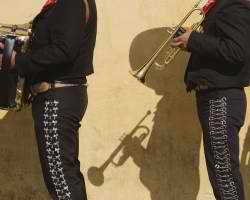Mariachi music is embedded in Mexican culture and, to a degree, American culture. It’s an instantly recognizable form of music—all bright brass and rhythmic guitar in three-quarter time.
But what is this music? The answer is more complicated than it might seem at first glance. Mariachi is not just something that evolved on its own from whole cloth. Rather, it is a syncretic music —something that has emerged from the collision of very disparate cultures.
The origin of the word “mariachi” is emblematic of its heritage: nobody seems to be able to agree where it came from.
According to some linguistic schools of thought, it is a corruption of the French word “marriage,” meaning “marriage,” and referring to where the music was traditionally played in the 1800s. The parallel theory, and one that has gained considerable ground, is that the word comes from Coca, a now-extinct indigenous language in Jalisco state, and referred to a tree used to make guitars.
Mariachi’s instruments, like its style and history, are products of cultural fusion. When Hernán Cortes invaded Mexico in the 1500s, he had brought musicians along with him, who carried European instruments like the small stringed vihuela, the harp, the violin, and the guitarrón.
The European instruments were enthusiastically incorporated into the existing indigenous folk music of the time, a combination of woodwinds, conch shells, and drums and rattles. The folk music of Jalisco’s indigenous populations also lent their energy and tone to what became mariachi music, but its 3/4 time signature – which gives it a waltz-like rhythm – comes from somewhere else entirely: Africa’s west coast, via migration and the then-pervasive slave trade.
However, mariachi didn’t get its most distinctive characteristic until well into the 20th century. The trumpets, which make mariachi music instantly recognizable, were added around the 1950s so that the music would be more distinctive on broadcast radio and so that cinema orchestras could be better heard.
Today, mariachi has become one of the most recognizable pieces of Mexican musical culture, both within and without Mexico. Its storied history, like its style and instruments, encapsulate the country’s past, recent and ancient.















